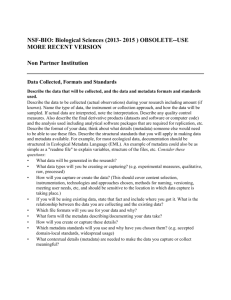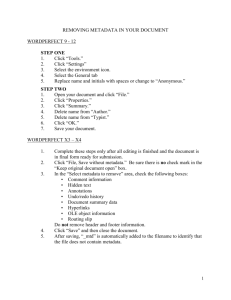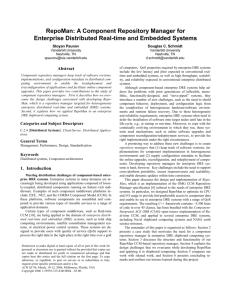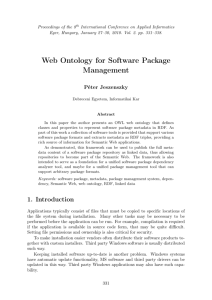Software Deployment Security: Attacks on
advertisement
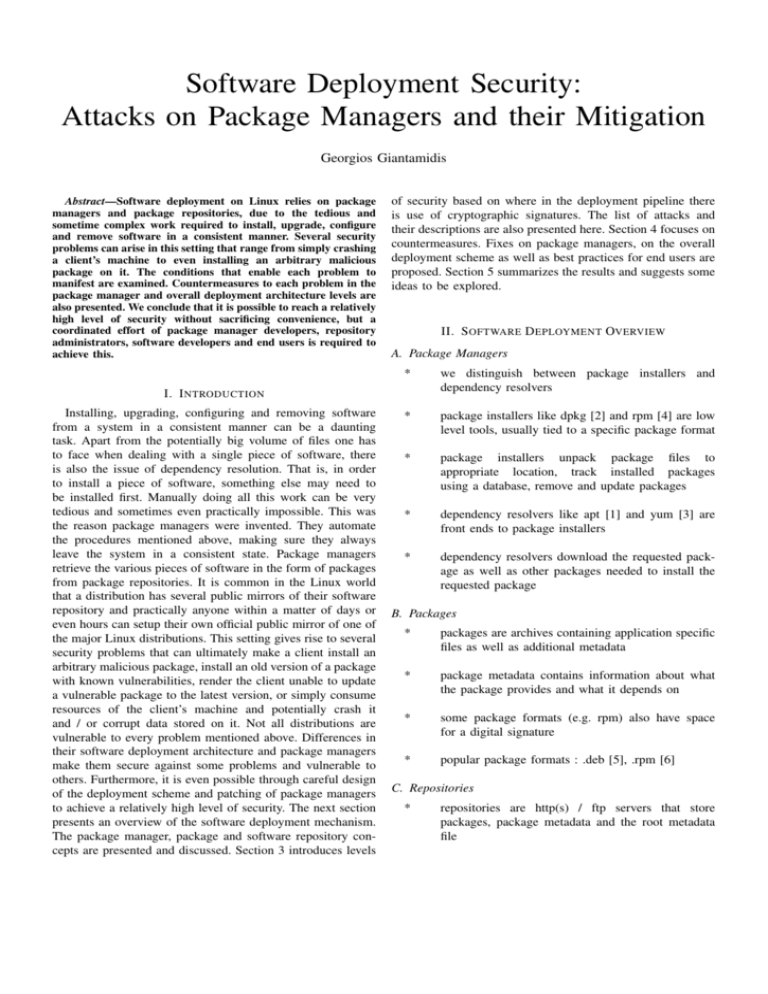
Software Deployment Security: Attacks on Package Managers and their Mitigation Georgios Giantamidis Abstract—Software deployment on Linux relies on package managers and package repositories, due to the tedious and sometime complex work required to install, upgrade, configure and remove software in a consistent manner. Several security problems can arise in this setting that range from simply crashing a client’s machine to even installing an arbitrary malicious package on it. The conditions that enable each problem to manifest are examined. Countermeasures to each problem in the package manager and overall deployment architecture levels are also presented. We conclude that it is possible to reach a relatively high level of security without sacrificing convenience, but a coordinated effort of package manager developers, repository administrators, software developers and end users is required to achieve this. of security based on where in the deployment pipeline there is use of cryptographic signatures. The list of attacks and their descriptions are also presented here. Section 4 focuses on countermeasures. Fixes on package managers, on the overall deployment scheme as well as best practices for end users are proposed. Section 5 summarizes the results and suggests some ideas to be explored. II. S OFTWARE D EPLOYMENT OVERVIEW A. Package Managers * we distinguish between package installers and dependency resolvers * package installers like dpkg [2] and rpm [4] are low level tools, usually tied to a specific package format * package installers unpack package files to appropriate location, track installed packages using a database, remove and update packages * dependency resolvers like apt [1] and yum [3] are front ends to package installers * dependency resolvers download the requested package as well as other packages needed to install the requested package I. I NTRODUCTION Installing, upgrading, configuring and removing software from a system in a consistent manner can be a daunting task. Apart from the potentially big volume of files one has to face when dealing with a single piece of software, there is also the issue of dependency resolution. That is, in order to install a piece of software, something else may need to be installed first. Manually doing all this work can be very tedious and sometimes even practically impossible. This was the reason package managers were invented. They automate the procedures mentioned above, making sure they always leave the system in a consistent state. Package managers retrieve the various pieces of software in the form of packages from package repositories. It is common in the Linux world that a distribution has several public mirrors of their software repository and practically anyone within a matter of days or even hours can setup their own official public mirror of one of the major Linux distributions. This setting gives rise to several security problems that can ultimately make a client install an arbitrary malicious package, install an old version of a package with known vulnerabilities, render the client unable to update a vulnerable package to the latest version, or simply consume resources of the client’s machine and potentially crash it and / or corrupt data stored on it. Not all distributions are vulnerable to every problem mentioned above. Differences in their software deployment architecture and package managers make them secure against some problems and vulnerable to others. Furthermore, it is even possible through careful design of the deployment scheme and patching of package managers to achieve a relatively high level of security. The next section presents an overview of the software deployment mechanism. The package manager, package and software repository concepts are presented and discussed. Section 3 introduces levels B. Packages * packages are archives containing application specific files as well as additional metadata * package metadata contains information about what the package provides and what it depends on * some package formats (e.g. rpm) also have space for a digital signature * popular package formats : .deb [5], .rpm [6] C. Repositories * repositories are http(s) / ftp servers that store packages, package metadata and the root metadata file * repository root metadata contains the location and secure hashes for package metadata tarballs * often there are multiple official mirrors of the main repository * (repository structure image here) C. Best user practices * use only trusted repositories * update manually, not automatically * use https if possible to protect against MITM attacks * use package managers that sign repository metadata * use package managers that implement metadata expiration III. S ECURITY L EVELS AND ATTACKS ON PACKAGE M ANAGERS [7]–[9] V. S UMMARY AND F UTURE E XPLORATIONS A. Security Levels * no signatures at all * signatures on individual packages * signatures on package metadata * signatures on root metadata B. Attacks * arbitrary (malicious) package * replay attack (client installs old, vulnerable package) * freeze attack (client can’t update to new package) * extraneous dependencies * endless data (consumes resources of client’s machine - may corrupt disk data) C. which attacks affect each security level? IV. C OUNTERMEASURES [7]–[9] A. Fixes on overall architecture * use signatures * a combination of signatures on root metadata as well as on individual packages provides a good level of security and convenience B. Fixes on package managers * package managers should take as much advantage as possible of the underlying deployment infrastructure * e.g. yum did(does?) not verify whether the package metadata initially received for dependency resolution matches the embedded metadata of the downloaded packages, which allows forging package metadata to launch an extraneous dependencies attack TODO R EFERENCES [1] [2] [3] [4] [5] [6] https://wiki.debian.org/Teams/Apt https://wiki.debian.org/Teams/Dpkg http://yum.baseurl.org/ http://rpm.org/ .deb package format : http://linux.die.net/man/5/deb .rpm package format : http://www.rpm.org/max-rpm/s1-rpm-file-format-rpm-file-format.html [7] Justin Cappos, Justin Samuel, Scott Baker, and John H. Hartman. 2008. A look in the mirror: attacks on package managers. In Proceedings of the 15th ACM conference on Computer and communications security (CCS ’08). ACM, New York, NY, USA, 565-574. DOI=http://dx.doi. org/10.1145/1455770.1455841 [8] https://isis.poly.edu/∼jcappos/papers/cappos pmsec tr08-02.pdf [9] https://www.usenix.org/legacy/publications/login/2009-02/openpdfs/ samuel.pdf


